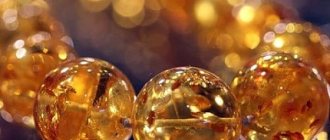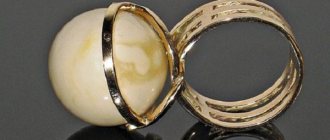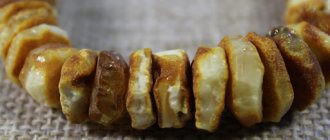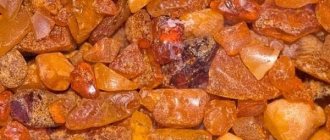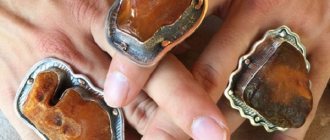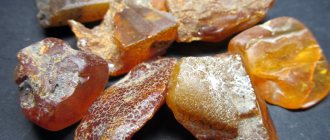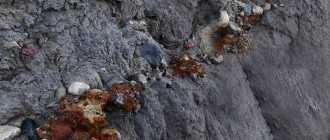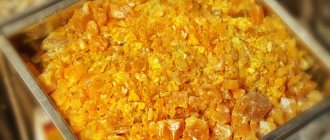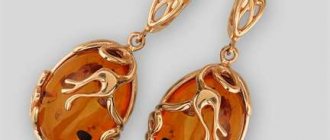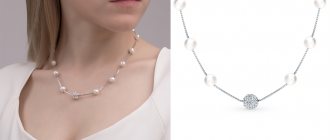“Where is your amber with dinosaur remains?” The staff of the Amber Museum hears this question from both the youngest visitors and their parents. In a display case with inclusions - that's what amber with inclusions is called - they linger for a long time. And it’s not surprising, because all these insects are the same age as the sun stone, which, in turn, is more than 40 million years old. Aristotle mentioned inclusions in his works; they were often kept in the treasuries of monarchs, and the largest pre-war collection of amber with inclusions was in Königsberg. It is almost completely lost, but even today the Amber Museum has something to surprise. The most valuable frozen curiosities are in our selection.
Fossil bird feather
All fans of the film “Jurassic Park” will be disappointed: dinosaurs became extinct long before the formation of Baltic amber, so such inclusions cannot exist in the sunstone. However, the museum exhibit contains a sample in which the feather of an ancient bird is frozen. Scientists are inclined to believe that it was a diatryma - a direct descendant of dinosaurs. With a height of two meters and a weight of 100 kilograms, she led a predatory lifestyle and ate horses, among other things. The bird could not fly, but it ran fast enough that a feather could stick to a drop of fresh resin during a hunt. A stone with a surprising inclusion was discovered by a local collector while processing raw amber and in 2010 was transferred to the collection of the Amber Museum.
Where are stones with inclusions most often found?
Stones with inclusions have been found on all continents, with the exception of Antarctica. The largest deposit is the Baltic-Dnieper province. It includes: Denmark, Germany, Poland, the Kaliningrad region of Russia, the Baltic states, Belarus, Ukraine.
Also, significant deposits of the gem were found in the tropics and subtropics - on the Caribbean Islands, Haiti, the Dominican Republic, and Mexico.
Amber with insects inside is mined using the quarry method: a quarry is dug, the top layer of soil is removed and the stone is mined, cleaned and sorted.
In addition, watch the video:
Lizard
If you see in souvenir shops on the Baltic coast a piece of amber the size of a palm, in which a lizard flaunts like a model, do not delude yourself. There are seven real such inclusions all over the world, and one of them is kept in the Amber Museum. And it is quite difficult to recognize a lizard in this inclusion with the naked eye. These invertebrate animals fell into the resin already dead, but in another situation they could easily get out of there, throwing off only their tail. The find was discovered in 2008 in an amber deposit in the village of Yantarny.
Stages of formation of amber inclusions
The entire process of amber formation can be divided into three stages:
- Stage 1 – Hardening. Namely, increasing the density of the substance due to the evaporation of the volatile part of turpentine. As a result, the color of the material also changes - it becomes darker and more saturated.
- Stage 2 – Fossilization. This is the process of turning dead plants into fossils and occurs after the resin gets underground. Its main conditions are the influence of environmental factors and the passage of diagenesis (transformation). At the end of the second stage, the melting point of the resins increases, their solubility decreases significantly, and the color becomes yellow.
- Stage 3 – Formation of amber. During this period, the resins are transferred and adjusted in water basins. In this case, glauconite is formed - a mineral that accompanies the accumulation of amber.
Varieties of amber in which inclusions are found. The color of this mineral varies from light yellow to black. And taking into account the shape, shades and degree of transparency, there are 5 main types of it. The most common, accounting for 98% of the entire amber market, is succinite or Baltic amber. It comes in many varieties (eg batter, bone, smoky, cloudy, red, layered, foamy, overburden). It is in the layered, so-called “puff” layer that 80% of all inclusions are located. The remaining four types are considered amber-like: glossite (that is, opaque or brown), bockerite (opaque and dark), gedanite (waxy yellow), stantienite (black).
Centipede
This invertebrate animal with the beautiful name “Scutiger centipede” is a very rare and unusual inclusion in amber. Better known as the flycatcher, it hunted not only flies, but also termites, spiders and cockroaches. With a sharp movement of her 15 legs, she knocked down flying insects and, without allowing them to come to their senses, killed them by injecting poison, and then ate them. During one of these hunts, the centipede fell into the resin.
Inclusions in amber: 15 photos
Amber with inclusions is a very rare and valuable find not only for scientists, but also for jewelers. Insects frozen in fossilized resin can reveal a lot about the fauna of ancient times. And for jewelry connoisseurs, this is a unique thing, because there is definitely no other such product of nature on Earth.
Dragonfly
imgur
Of all the amber collected on the planet, only 5% contain inclusions. Moreover, for the most part these are representatives of the flora and fauna of the times of dinosaurs!
Paleozoic lizard in Baltic amber
imgur
90% of all amber mined is Baltic amber or succinite. According to scientists, it was formed in the middle of the Paleogene period, which is about 65-55 million years ago - just when dinosaurs lived
An arachnid that lived millions of years ago
imgur
Over the past five years, the price of real amber has doubled, so it can be a good investment and savings vehicle. In particular, demand for amber from the Baltic countries has increased in China, so that the price has skyrocketed from $30 to $70. Amber with insects is even more expensive, because this is only 5%
Ancient flower in amber
Poinar
98.3% are animals in amber, 0.4% are plants, and 1.3% are reptiles, mollusks, minerals, inclusions of air and water
Caddisfly
Insects in amber from ancient times differ little from modern ones, only 1% of them are extinct species
A praying mantis that lived 12 million years ago
These are especially carefully studied by scientists who want to learn as much as possible about the world of the dinosaur times.
Gecko 54 million years old
Amber is the fossilized resin of plants and trees, which they secrete to protect against pests and predators. Accordingly, these are the organisms most often frozen in resin and perfectly preserved for millions of years, so now scientists can study their habits
This snake lived 50 million years ago
Take, for example, a wingless female insect found in amber that lived 100 million years ago, during the Middle Cretaceous period. The discovery was made in a mine in the Hukaung Valley in Myanmar. A new insect hitherto unknown to science was named Aethiocarenus burmanicus, and its order was named Aethiocarenodea
Aethiocarenus burmanicus
Poinar
The main distinguishing feature of this creature was the ability to turn its head 180 degrees! Not a single living insect can do this!
Chimerarachne yingi
Wang
But Chimerarachne yingi is another find not for the faint of heart. This arachnid crawled through the rainforests of what is now southeast Asia more than 100 million years ago, during the Cretaceous period, during the time of the dinosaurs. The tail of these creatures was longer than their body and was apparently used as a sensory detector for finding prey or avoiding other large predators. A similar tail - the telson - is now used by scorpions, but this has never been found in spiders before.
Spider attacks wasp
O.S.U.
So insects in amber are often very unique. There is even a specimen of amber in which a spider froze while attacking a wasp in its web (both species are already extinct)! Fifteen intact strands of spider silk are perfectly preserved, and the attack scene itself is considered the first fossil evidence of such an attack.
dinosaur tail
In addition, the remains of another spider were found in amber, which also allows scientists to speculate about the social behavior of these insects at that time. The find dates back to the Early Cretaceous period - approximately 97-110 million years ago.
So if you are lucky enough to find real amber with inclusion on sale, check its authenticity and do not hesitate to invest in such a unique jewel!
A fly that is 50 million years old
Its value is forever
See also: 12 interesting facts visually, in photo comparisons
Finds in hardened resin
As already described above, inclusions are divided into botanical and zoological. Although the former are much less common, they do a good job of reflecting the ecosystem of those times. It included both coniferous plants - pines, thujas, cedars, araucarias, swamp cypresses - and deciduous plants (chestnuts, palm trees, maples, willows). Almost all precious stones contain oak pollen, which means that these trees were very widespread in Europe at that time. An exclusive cabochon belonging to entomologist J. Poinar (USA) is interesting - it contains an entire inflorescence, the age of which exceeds 100 million years. And hidden in a nugget from the Oligocene era (33.9-23.03 million years BC) is a shoot of a roridula, related to the mosquito-hunting sundew.
| Zoological inclusion | Botanical inclusion |
Amber research
In the diaries of the famous philosopher Immanuel Kant there is such an appeal to a fly frozen in a gem: “Oh, if you could speak, how our knowledge of the past would change.” In the 18th century, during the life of the thinker, such words were just a fantasy, but gradually they came to life! For modern specialists, every inclusion is a chance to learn something new about things that have long disappeared from the face of the Earth.
Amber research
How to distinguish a fake from a real stone
There is a whole industry that skillfully counterfeits amber mineral with inclusions. The fashion for unusual stones has provoked a whole stream of fraud.
Ways to distinguish a fake from a real natural formation:
- in a real stone, the insect is in an “uncomfortable” position, a beautiful scorpion in a mineral as transparent as a tear is more likely a fake, a real one is usually twisted, broken and not so elegant;
- irradiation with UV rays will immediately reveal the artificial plastic, it will not change, and natural amber will shimmer with multi-colored rays.
The main rule for competently purchasing amber jewelry is to contact a specialized network. The website amberika.ru has been selling amber jewelry for many years. Our impeccable reputation is a guarantee of an honest and clean transaction!
Types of inclusions
Ticks and dragonflies, snakes and lizards, bees and scorpions, leaves and pieces of bark - everything was found in solar gems. To make it easier to recognize amazing inclusions, several classifications have been created:
- by origin: plant (pollen, spores, moss, seeds, buds) and animals (insects, arachnids, reptiles, amphibians, mollusks);
- by size: microinclusions (less than 1 mm), mesoinclusions (1-5 mm) and macroinclusions (more than 6 mm);
- by condition: well-preserved (you can study small details of the structure of the creature imprisoned inside), decomposed (there are whitish opacities, bubbles, spots around the object) and destroyed.
| Cricket in amber | Wasp in amber |
Methods for studying inclusion
The earliest techniques used when working with stones were cutting and polishing. Of course, this revealed only inclusions visible to the naked eye, and moreover, priceless finds were often lost due to the inattention or careless movement of the master. After the invention of magnifying glasses, naturalists examined more miniature objects, but only in transparent gems - matte ones were still unavailable. Already in 1742, Nathan Sendel’s book on inclusions in amber was published in Leipzig.
2D images of 3D models of fossil organisms encased in opaque amber
a — gastropod mollusk from the family Ellobiidae; b —centipede from the family Polyxenidae; c - spider; d —shoot of a gymnosperm plant from the genus Glenrosa; e is an isopod crustacean of the genus Ligia; f - hymenopteran insect from the family Falciformicidae
A virtual three-dimensional model of a previously unknown insect from the family Falciformicidae
- Transmission phase-contrast microradiography and spectral analysis not only create a three-dimensional image of the object, but also restore its original color!
- X-rays and microscopes opened up new horizons for researchers. Now they could penetrate deep into the cabochons and see wonderful creatures there.
- Computed tomography made it possible to obtain detailed photos and 3D models of inclusions.
- Radiocarbon dating makes it easier to date the hardened resin - the age of the cabochon is determined by the number of carbon-14 isotopes. In addition, the so-called “geologists’ calendar” is used for similar purposes, based on the remains found in gems.
Image of a fragment of opaque amber obtained using: a - absorption microradiography; b — transmission phase-contrast microradiography.
